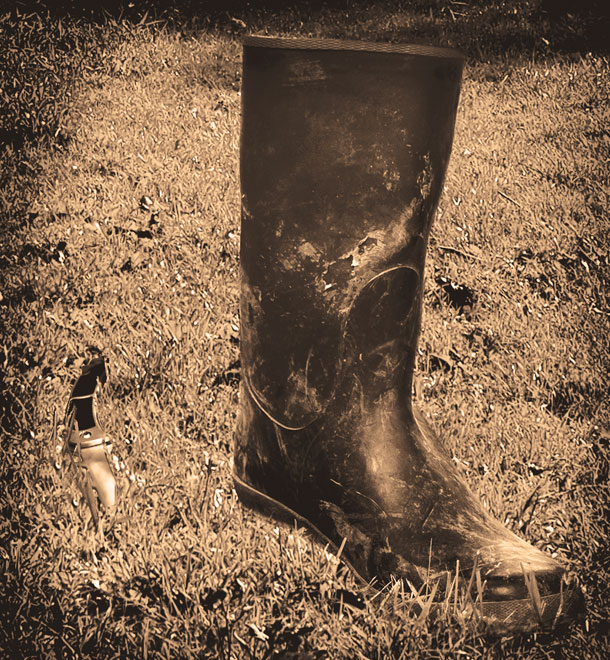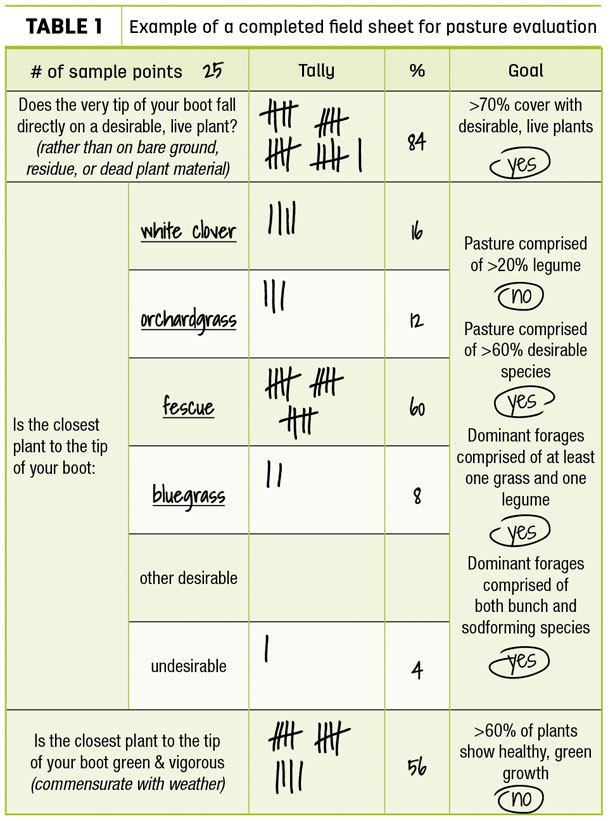But pasture evaluation is important to do and can be a great tool for making management decisions. I’d like to offer a quick and easy method for evaluating your cool-season perennial pastures: the “step-point” method.
What is the step-point method?
The step-point method is a simple process for measuring various features of a pasture. Begin by selecting a spot on the tip of your right boot. Some people cut a small V-notch in the toe of their boot, but you can also just designate the toe of your boot. This will become your sampling point. Walk across the entire pasture and record what is encountered where the toe of your boot lands.
To cover enough area, you’ll want to record only every 10th step or so. Walk in an S-shaped pattern across the field, and try not to look down until you are stopped at your sampling locations; otherwise, you risk unconsciously biasing where you step.

The whole idea behind the step-point method is to remove any guesswork or bias in what is to be recorded. It also provides a consistent way of evaluating pastures that is directly comparable from year to year. Another benefit of the step-point method is that it is actually used in a lot of university research to measure and report things.
A case in point: I’ve found many studies showing that pastures comprised of at least 15 to 20 percent legumes (measured using the step-point method) consistently provide a 1/2-pound-per-day increase in calf gains. That is a lot more meaningful to me than recommendations that say to increase legume content to 25 to 50 percent on a dry matter basis. I don’t know anyone who has the time to measure the dry matter legume content of their pastures.
What should I evaluate?
Let’s say you walk a pasture, stopping to record data after every 10th pace of your right foot. At each of these sampling locations, you record:
- If the toe of your boot is on bare ground or vegetation
- The species of the nearest plant
- Whether that plant shows good color and growth
Once you get a system down, this process should take less than 30 seconds per sampling location. If you record information at 25 spots, you should have a fair representation of the pasture that takes 30 minutes or so to gather (depending on how fast you travel).
From the information gathered, you can easily run the numbers to see how well your pasture matches up to established goals for plant cover, plant vigor and species diversity (shown in Table 1).

Your goals may vary depending on many factors, but these are good ones for most cool-season perennial pastures in high rainfall or irrigated situations. You can adjust them for your area.
Since pasture composition changes across the season, you should ideally evaluate a pasture during the time of year that’s most important to you. Also, avoid evaluating pastures right after they’ve been grazed if possible – give some time for plants to regrow and provide a clearer picture of the situation.
Good questions lead to good management
The quality of your management is directly dependent on the quality of the questions you ask. Good pasture evaluation records won’t tell you what to do, but they will help you ask the right questions that lead to better management.
-
Plant cover: Your records show several years of declining plant cover and increasing weeds or bare ground. Is a strategic herbicide application or reseeding all that’s necessary to get things back up to snuff, or do you need to look deeper to see if poor grazing practices are the underlying cause of the decline in the stand?
-
Legume content: The legume content of your pasture has been poor for several years. Are your soil phosphorus and pH levels high enough to support legumes? If so, are you reseeding or enabling natural reseeding of legumes on a frequent basis (every two to three years)? Do you adequately suppress grass competition to legumes during establishment?
-
Species diversity: Do you have at least one legume species present to contribute nitrogen to the system and improve forage quality? Do the predominant forage species complement each other to enhance productivity? For example, does your pasture contain a sod-forming species such as Kentucky bluegrass or smooth brome that can help fill in bare areas in between bunchgrasses? If the amount of toxic tall fescue is on the rise in pastures your spring herd breeds on, is it time to consider a stand replacement with a novel fescue?
- Plant vigor: Does much of the pasture show light-green color and poor growth despite decent growing conditions? If so, you may want to take a closer look at soil fertility and grazing management. Is your grazing management doing a good job of redistributing nutrients over the entire pasture, or are nutrients concentrated at shade and water areas? Are livestock grazing off too much of the leaf area?
Feel free to call or email me for a digital copy of the evaluation template used here. I’ll admit that walking around the field with a notebook may appear too nerdy for some people. If nothing else, get out of the truck and walk your pastures, observe and ask questions. You can tell any gossipy neighbors that you are looking for a pocketknife you dropped. ![]()
GRAPHIC: I’ll admit that walking around the field with a notebook may appear too nerdy for some people. If nothing else, get out of the truck and walk your pastures, observe and ask questions. You can tell any gossipy neighbors that you are looking for a pocketknife you dropped. Graphic by Corey Lewis.

-
Matt Booher
- Crop and Soil Extension Agent
- Virginia Tech Cooperative Extension – Augusta County
- Email Matt Booher









